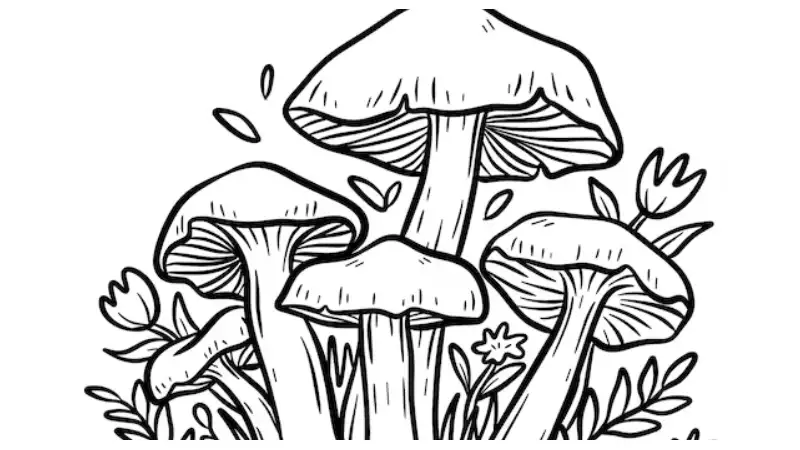Drawing:plcxcsjeqpq= mushroom offers a unique way to explore the intricate details of nature through art. With their diverse shapes, textures, and vibrant colors, mushrooms present an exciting challenge for artists of all levels. Did you know that there are over 10,000 known species of mushrooms, each with distinct characteristics?
This guide provides a comprehensive approach to mastering the art of drawing:plcxcsjeqpq= mushroom, covering everything from basic anatomy and sketching techniques to shading and adding color. By understanding the anatomy of mushrooms, such as the cap, gills, and stem, you can create realistic or whimsical illustrations.
Learn how to use different tools, like graphite pencils and watercolors, to bring your drawings to life. Avoid common mistakes, refine your skills, and find inspiration for creative mushroom art. Whether you’re a beginner or an experienced artist, this guide will help you create beautiful, detailed mushroom drawings that capture nature’s charm.
Why Draw Mushrooms?
Drawing mushrooms can be a therapeutic and imaginative way to explore nature’s intricate designs. The shapes, colors, and patterns of mushrooms provide endless possibilities for creative expression. Artists often draw mushrooms too:
- Explore Nature’s Diversity: Mushrooms come in countless shapes and colors, making them perfect subjects for studying form, texture, and shading.
- Improve Drawing Skills: Drawing a mushroom involves mastering curves, organic shapes, and intricate details, which can improve your overall drawing skills.
- Create Whimsical Art: Mushrooms add a touch of fantasy to artwork, often featuring magical and fairytale-inspired scenes.
Understanding Mushroom Anatomy
Before you start drawing mushrooms, it is essential to understand their anatomy. Knowing the different parts will help you create more accurate and detailed illustrations. Here are the main components of a mushroom:
- Cap (Pileus): The cap is the top part of the mushroom, often dome-shaped or flat. It can have various textures, from smooth to scaly.
- Gills (Lamellae): The underside of the cap contains gills, which radiate out from the stem. These fine lines can add depth and detail to your drawing.
- Stem (Stipe): The stem supports the cap and can be thick or slender, straight or curved.
- Ring (Annulus): Some mushrooms have a ring around their stem, formed from a veil that once protected the gills.
- Base (Volva): The base anchors the mushroom in the ground and is often surrounded by a cup-like structure called the volva.
Materials Needed for Drawing Mushrooms
To draw a mushroom, gather the following materials:
- Sketchbook or Drawing Paper: Choose a medium-weight paper that can handle erasing and shading.
- Graphite Pencils: Use a range of pencils, from H (harder lead) for light lines to B (softer lead) for shading.
- Eraser: A kneaded eraser is great for correcting mistakes and softening lines.
- Blending Tools: Use blending stumps or cotton swabs to smooth out shading.
- Colored Pencils or Watercolors: These are optional if you want to add color to your mushroom drawing.
Step-by-Step Guide to Drawing a Mushroom
Let’s dive into a simple step-by-step guide to drawing a mushroom. This guide is suitable for beginners but can be adapted for more complex illustrations.
Step 1: Draw the Cap
Start by sketching a curved line to outline the top of the mushroom cap. The cap can be round, flat, or even cone-shaped, depending on the type of mushroom you want to draw. Experiment with different shapes to create a unique mushroom cap.
Step 2: Outline the Stem
Draw a straight or slightly curved line extending down from the cap for the stem. The stem should taper slightly as it reaches the ground. Keep your lines light and adjustable at this stage, so you can refine the shape as needed.
Step 3: Add Details to the Cap
Add details to the cap by sketching textures, such as small bumps, spots, or striations. Focus on the shading to create a three-dimensional effect if you are drawing a mushroom with a smooth cap.
Step 4: Draw the Gills
Under the cap, sketch the gills with fine, evenly spaced lines radiating outward from the stem. The gills add a sense of depth and complexity to your drawing. Make sure the lines are gentle and gradually curve downward as they reach the edge of the cap.
Step 5: Refine the Stem and Add a Ring
Refine the shape of the stem by adding a slight curve or taper. If your mushroom has a ring, draw a small circle or oval around the stem. The ring should look like a thin collar that wraps around the stem.
Step 6: Sketch the Base
Draw the base of the mushroom, adding a few lines to suggest a rough or uneven texture. If your mushroom has a volva, sketch a cup-like shape around the bottom of the stem.
Step 7: Add Shading and Depth
Shading is crucial for making your mushroom look realistic. Use a soft pencil (e.g., 2B or 4B) to add shadows where the cap overlaps the stem. Blend the shading gently with a blending tool to create a smooth transition between light and dark areas.
Techniques for Drawing Realistic Mushrooms
If you want to take your mushroom drawings to the next level, try these techniques for creating realistic textures and details.
Focus on Texture
Different mushrooms have unique textures, such as smooth, scaly, or velvety surfaces. Use short, controlled pencil strokes to replicate these textures on the cap and stem. For scaly caps, add small, overlapping shapes to mimic the look of scales.
Use Reference Photos
Reference photos are invaluable when drawing:plcxcsjeqpq= mushroom. They help you observe the intricate details of different mushroom species. Look for photos with clear lighting and varied angles to understand how shadows fall on the cap and stem.
Create Depth with Layered Shading
Layered shading gives your drawing a three-dimensional appearance. Start with light shading and gradually build up darker tones in areas where shadows naturally occur. Pay attention to where the light hits the mushroom, leaving those areas lighter to create contrast.
Experiment with Different Mushroom Types
Mushrooms come in an array of shapes and sizes, from classic toadstools to delicate morels. Experiment with drawing different types of mushrooms to develop your skills. Try drawing a tall, slender mushroom, followed by a round, squat one to challenge yourself.
Adding Color to Your Mushroom Drawing
Adding color can bring your mushroom drawing to life. Colored pencils and watercolors work well for adding vibrant hues and subtle gradients.
Using Colored Pencils
Colored pencils allow for precise control over shading and layering. Start by applying a light base layer of color to the cap and stem. Use darker shades to add shadows and details. Blend the colors smoothly using a blending pencil or a soft cloth.
Watercolor Techniques
Watercolors can give your mushroom drawings a soft, ethereal look. Begin with a light wash of color for the cap, allowing the paint to spread naturally. Add darker tones once the base layer is dry to enhance depth and contrast. Use a fine brush for detailed areas like the gills.
Common Mistakes and How to Avoid Them
drawing:plcxcsjeqpq= mushroom can be tricky, especially if you are new to illustrating natural subjects. Here are some common mistakes and tips on how to avoid them:
- Drawing Too Rigidly: Mushrooms have organic, flowing shapes. Avoid drawing them with stiff, straight lines. Use gentle curves and vary the thickness of lines to create a natural look.
- Over-Shading: While shading adds depth, too much shading can make the drawing look muddy. Focus on keeping the light source consistent and use lighter shading for areas that should remain bright.
- Ignoring Proportions: Make sure the cap, stem, and base are proportionate. A large cap with a tiny stem can look unbalanced unless you are intentionally drawing a whimsical or stylized mushroom.
Inspiring Mushroom Drawing Ideas
If you’re looking for inspiration, here are some creative mushroom drawing ideas:
- Fantasy Mushrooms: Draw mushrooms with glowing caps or magical elements, such as fairy lights or mystical patterns.
- Mushroom Landscapes: Create a forest scene filled with various mushrooms, from tiny clusters to large, towering fungi.
- Botanical Illustrations: Focus on accuracy and detail to create botanical-style mushroom illustrations, similar to those found in field guides.
Final Thoughts
drawing:plcxcsjeqpq= mushroom can be a fun and satisfying way to explore your artistic abilities. With practice and patience, you will be able to create intricate and lifelike mushroom illustrations. Use this guide to experiment with different styles, techniques, and materials.
As you refine your skills, you will discover new ways to express the beauty of mushrooms through your art. Whether creating whimsical scenes or botanical studies, drawing:plcxcsjeqpq= mushroom allows you to connect with nature and unleash creativity.
Here you can read: Error Code FintechAsia: Understanding the Issue and How to Resolve It
Read Also: Building Micronaut Microservices Using MicrostarterCLI

